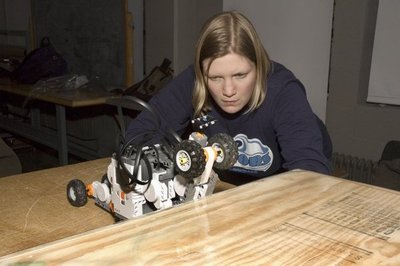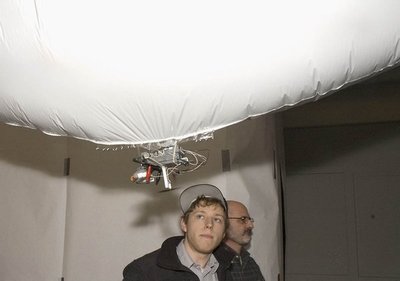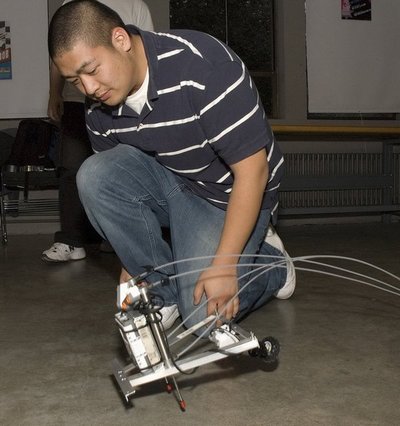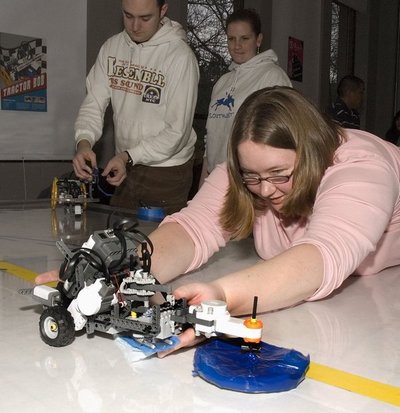March 29, 2007
Communication, cooperation, interdisciplinarity — and some very cool robots
Room 236 of the Art Building was alive with robots one afternoon during finals week. Scrappy little machines with rudimentary minds of their own, they rolled, crawled, hopped and even flew about the room, followed closely by their student inventors.
This afternoon of pleasant chaos was the final meeting of Art 483: Fundamentals of Interface Design, more simply known as Designing Behaviors. Simply put, the team-taught class brought together students from design, computer science, technical communication and digital arts/experimental media, to see what kinds of cool things they could create.
The class was taught by Andrew Davidson, affiliate assistant professor, and Axel Roesler, assistant professor, both in the School of Art’s Division of Design. The students built their robots using the LEGO Mindstorms system of programmable robots — basically very smart toys — with various motors and sensors to accomplish the behavior they want. You can learn more at http://courses.washington.edu/art483/.
“The robotic thing is just a vehicle,” Davidson said. “The idea is really to provide a meeting ground for students of different disciplines to work together.”
The students were not controlling the small robots remotely; that’s not the point, he said — rather, they programmed behaviors into their little LEGO computer brains that tell the machines how to react and what to do in certain situations — behaviors such as changing course in the face of an obstruction, or even calling another robot for help.
Such was the case with the robots Tractor Bob and Malachi. The two were programmed and equipped to leave felt-marker lines behind them wherever they traveled on a white board used here as a playing field. But they were programmed not to cross their own lines and so occasionally became trapped within boundaries of their own creation.
Who did they call? Why, the Big Zamboni, of course — an aptly named fellow robot dragging a round pad behind it that erased all felt marker lines it encountered. Heeding the call, Zamboni would stop its own unmapped wanderings to come over and wipe out lines to free Tracker Bob or Malachi.
Then there was the Mylar blimp, about 6 feet long and powered by a small motor and propellers in its cab, which was designed to adjust its path to avoid collisions or tight corners. The blimp cruised the room throughout the session, usually at head level or just above, and despite its programming occasionally did bump something or quietly motor itself into a corner, to be redirected by its inventors.
Across the room, the Stair Climber was doing its thing — or trying to. This one’s a machine with two brains — one in front and one in the back — which communicate to enable it to navigate climbing up steps. The front portion scopes out the angle and how the machine needs to move to make the climb successful, then the back end tries to follow along. Dust on the wooden tabletop kept Stair Climber from getting sufficient grip to move ahead and climb, but that was later remedied by using a vinyl covering over the dusty plywood stair surface.
Then there were the Recursive Robots — a project where three robots programmed with distinct “personalities” or quirks of behavior both create and react to their environment. The robots’ world is a darkened area of the room with a projector showing three colored circles — blue, green and red — on the floor whose colors correspond with and are affected by the three robots. The more one looked, the student inventors wrote in notes about the project, the more the robots’ personalities come through. “(Viewers) will soon unravel the connections between the robots and what kinds of metaphors and comparisons to human behavior are contained within the system.”
Communication such as that promoted by the Designing Behavior class clearly has value far beyond the classroom, Davidson noted. And it all starts with students from dissimilar backgrounds coming together for a single purpose.
“I’m amazed at the collaboration,” Davidson said amid the chatter of young innovators and softly whirring LEGO motors during the session. “It’s the most interesting part of this, pedagogically.”






